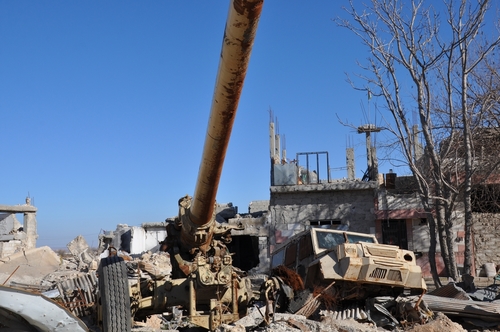Fighting in south Syria intensified in February and March as opposing forces vied for control of the city of Daraa.
Some residents have witnessed airstrikes targeting civilian structures. As bombings and aerial attacks in eastern Daraa increased, hospitals and medical structures in the area were forced to close to avoid being targeted. The fighting has also resulted in a surge of 30,000 internally displaced people. Many have fled to surrounding farmlands or returned to villages previously abandoned and destroyed.
MSF recently responded to this crisis with an emergency distribution of 893 kits of essential relief items, distributed to families in two areas.
Displaced people in south Syria face acute insecurity and limited access to aid and medical care. As their living conditions become more precarious, their health will further deteriorate.
Fighting has resulted in an increase in the number of injured. In the past two months, MSF has seen 65 war-wounded Syrians arrive at the emergency room of Ramtha hospital in northern Jordan. Thirty-seven of them were admitted to MSF’s emergency surgical project there.
MSF remains significantly constrained in its presence and medical activities, mainly due to shifting frontlines, insecurity in armed opposition areas and a lack of authorisation to operate in government-controlled areas.
MSF nevertheless continues to directly operate four health facilities in the north of Syria and a number of hospitals in the south. It also supports more than 150 health facilities nationwide.
Yet the capacity of these facilities is shrinking, with most facilities unable to respond to the specialised surgical needs of war-wounded Syrians.
Humanitarian and medical update
As bombing and aerial attacks in eastern Daraa have increased, many roads have been blocked or partially closed because of the conflict. This has resulted in difficulties in delivering humanitarian assistance.
In terms of healthcare, most hospitals are not receiving enough supplies and medications.
One of the biggest concerns at the moment is the protection of vulnerable populations and meeting their need for basic shelter.
There are few formal camps in the Daraa area and despite concerted efforts, the needs of the displaced population for proper shelter and tenting have still not been met.
Thousands of people live on the streets or on farmland, conditions which pose significant risks in terms of security and health.
Huge gaps in healthcare are affecting secondary, tertiary and mental health services, as well as those for chronic diseases and reproductive health. Routine vaccinations are also impacted.
Although MSF and the other organisations have sought to anticipate periods of increased violence, hospitals and medical facilities in the south as a whole continue to be understaffed and underfunded.
The lack of specific medical equipment and the very limited number of medical specialities still present in Syria have resulted in a fragile healthcare system, mostly decimated after six years of war.
According to recent information, an estimated 15,000 doctors have fled the country – almost half the number present in pre-conflict Syria. Hundreds of thousands of civilians are unable to receive even basic healthcare.





